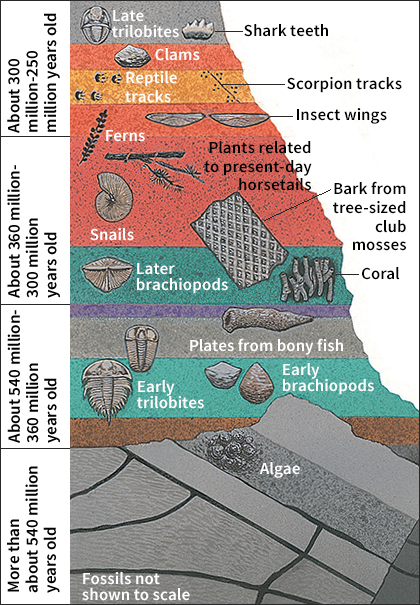Cambrian Period was a time in Earth’s history that lasted from 539 million years ago to about 485 million years ago. Geologists first identified rocks of this age in Wales (once called Cambria) in the early 1800’s. The Cambrian Period marks the start of the Paleozoic Era, a time when prehistoric life left behind an abundance of fossils.
The oldest fossils of animals date from the Ediacaran Period, the time just before the Cambrian Period. Creatures of the Ediacaran Period were mostly simple, soft-bodied animals. Eventually, more complex animals began burrowing deep into sediments (accumulated small bits of dirt and rock) on the sea floor. The earliest evidence of this activity marks the start of the Cambrian Period.
Many major types of animals first appear in fossils from the early Cambrian Period. Scientists often refer to this sudden, dramatic increase in the variety of animal fossils as the Cambrian Explosion. During the Cambrian Explosion, animals evolved (developed gradually) into many new forms and spread throughout all of Earth’s oceans. They also began interacting with one another and their environment in more complex ways. Animals began eating other animals, growing skeletons for protection, and burrowing into sea-floor sediments for food and shelter. The first reefs, built by early sponges and bacteria, also formed.

Marine life dominated during the Cambrian Period. No fossil evidence indicates that plants or animals lived outside of the oceans at this time. Some genetic studies, however, have suggested that certain plants and fungi may have lived on land. Trilobites, sea animals related to modern crabs, lobsters, and insects, rank as the most abundant Cambrian fossil. Trilobites flourished throughout the Cambrian Period.
During the Cambrian Period, most of Earth’s land lay in the Southern Hemisphere. The land consisted mainly of several large continents formed earlier in the breakup of a giant land mass called Rodinia. These continents continued to spread apart, and what is now North America drifted northward, crossing the equator in parts. Global sea levels rose through the Cambrian Period until most of the land was covered by oceans. The climate was generally warm, and ice probably did not cover Earth’s poles as it does today.
The extinction of certain species of trilobites and other animals marks the end of the Cambrian Period. No major animal groups disappeared, however, and there was no widespread global extinction like those that mark the end of many other periods in Earth’s history.
